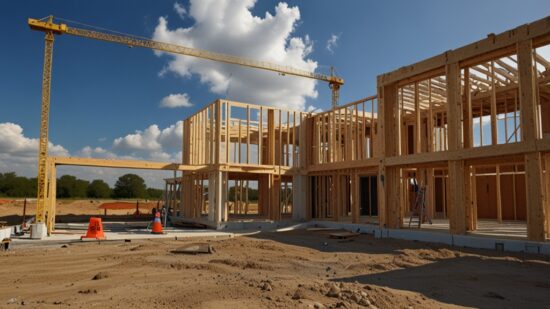
Building your dream home is an exciting venture, but it can also be a daunting process, especially when it comes to financing. For eligible veterans, active-duty service members, and their families, VA construction loans offer an excellent opportunity to turn the dream of homeownership into reality. The role of VA construction loan lenders is pivotal in this journey, as they bridge the gap between your vision and its execution. Here, we delve into the essential roles and responsibilities of VA construction loan lenders and how they help streamline the process of building your ideal home.
Understanding VA Construction Loans
Before exploring the role of lenders, it’s crucial to understand what VA construction loans are and how they differ from traditional financing options. A VA construction loan is a specialized product backed by the Department of Veterans Affairs (VA) designed to help eligible individuals finance the construction of a new home. These loans offer several benefits, including:
- No down payment requirement: Unlike conventional loans, VA loans often eliminate the need for a substantial upfront payment.
- Competitive interest rates: VA-backed loans typically offer lower interest rates compared to other financing options.
- No private mortgage insurance (PMI): Borrowers can avoid the added cost of PMI, which is usually required for conventional loans with low down payments.
- Flexible credit requirements: VA loans often have more lenient credit score requirements, making homeownership more accessible.
VA construction loans provide a single loan to cover both the construction phase and the permanent mortgage, simplifying the process for borrowers.
Key Responsibilities of VA Construction Loan Lenders
VA construction loan lenders play a vital role in ensuring the success of your home-building project. Their responsibilities extend beyond merely providing financing; they act as partners, facilitators, and advisors throughout the construction process. Here’s a closer look at their key responsibilities:
1. Assessing Eligibility and Prequalification
One of the first steps in obtaining a VA construction loan is determining your eligibility. Lenders review your VA Certificate of Eligibility (COE) to confirm that you meet the VA’s requirements. They also assess your financial situation, including your income, credit score, and debt-to-income (DTI) ratio, to determine how much you can borrow.
During the prequalification phase, lenders provide an estimate of your loan amount and outline the loan’s terms and conditions. This step is crucial as it sets realistic expectations for your home-building budget.
2. Facilitating the Loan Application Process
Applying for a VA construction loan involves multiple steps and extensive documentation. Lenders guide borrowers through this process by:
- Explaining the required paperwork, such as income statements, tax returns, and construction plans.
- Ensuring all forms and documents are accurately completed and submitted.
- Communicating with the VA to secure loan approval.
Lenders’ expertise in handling VA loan applications reduces the risk of delays and ensures a smoother experience for borrowers.
3. Collaborating with Builders and Contractors
A critical aspect of VA construction loans is the involvement of approved builders and contractors. Lenders work closely with these professionals to ensure that your construction project meets VA standards. They:
- Verify that builders are registered with the VA and meet eligibility criteria.
- Review construction plans and budgets to ensure compliance with VA guidelines.
- Coordinate with builders to establish timelines and milestones for the project.
By maintaining open communication with builders, lenders help ensure that the construction process proceeds without significant setbacks.
4. Managing Loan Disbursements
VA construction loans are structured to release funds in phases as the construction progresses. Lenders oversee this process by:
- Inspecting completed work at each stage of construction to verify progress.
- Disbursing funds to builders and contractors based on approved milestones.
- Ensuring that funds are used exclusively for construction-related expenses.
This phased disbursement approach protects both the borrower and the lender by minimizing financial risk and ensuring accountability.
5. Providing Ongoing Support and Guidance
Building a home involves many moving parts, and lenders often act as a support system for borrowers. They:
- Address borrower concerns and provide clarity on loan terms and processes.
- Offer advice on managing finances during the construction period.
- Resolve any issues that may arise during the construction process.
Lenders’ hands-on involvement ensures that borrowers feel confident and informed throughout their home-building journey.
Benefits of Working with VA Construction Loan Lenders
Choosing the right lender for your VA construction loan can significantly impact your home-building experience. Here are some benefits of working with experienced VA construction loan lenders:
1. Streamlined Loan Approval
VA loan lenders are familiar with the nuances of VA construction loans, allowing them to expedite the approval process. Their expertise ensures that all requirements are met promptly, reducing the risk of delays.
2. Access to a Network of VA-Approved Builders
Experienced lenders often have established relationships with VA-approved builders and contractors. This network can simplify the process of selecting reputable professionals for your project.
3. Customized Loan Solutions
Every borrower’s needs are unique, and VA loan lenders can tailor loan terms to match your specific circumstances. They take into account factors such as your budget, timeline, and construction goals to create a financing plan that works for you.
4. Lower Costs and Favorable Terms
Because VA loans are backed by the government, lenders can offer competitive interest rates and lower closing costs. These favorable terms make homeownership more affordable for veterans and their families.
5. Guidance on VA Standards and Requirements
Navigating VA guidelines can be challenging for first-time borrowers. Lenders’ knowledge of these standards ensures that your construction project complies with all VA requirements, avoiding potential issues down the line.
Choosing the Right VA Construction Loan Lender
Selecting the right lender is a critical step in your home-building journey. Here are some tips to help you make an informed decision:
- Research and Compare Lenders: Look for lenders with experience in VA construction loans. Compare their rates, terms, and customer reviews to find the best fit for your needs.
- Verify VA Approval: Ensure that the lender is approved by the Department of Veterans Affairs to originate VA loans.
- Ask Questions: Don’t hesitate to ask prospective lenders about their experience, loan process, and any fees associated with the loan.
- Seek Recommendations: Fellow veterans, military support groups, and online forums can be valuable sources of information and recommendations.
- Evaluate Customer Service: Choose a lender who communicates clearly, responds promptly, and prioritizes your needs.
Conclusion
The role of VA construction loan lenders in building your dream home cannot be overstated. From assessing your eligibility and guiding you through the loan application process to collaborating with builders and managing disbursements, lenders are indispensable partners in your journey to homeownership. By working with experienced and trustworthy VA construction loan lenders, you can navigate the complexities of financing and focus on bringing your vision of the perfect home to life. With their support, you’ll be well on your way to creating a space that reflects your style, meets your needs, and serves as a lasting testament to your hard work and dedication.

